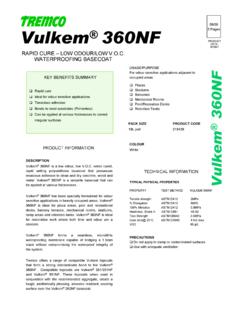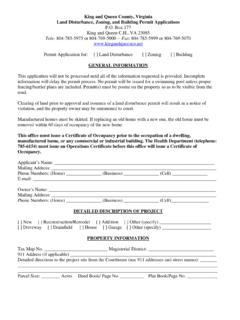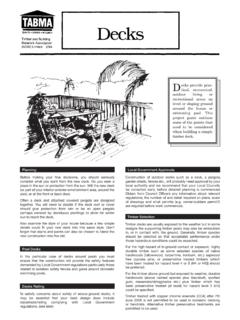Transcription of Lightning Safety When Working Outdoors
1 FactSheetLightning Safety when Working OutdoorsLightning strikes can severely injure or kill workers whose jobs involve Working Outdoors . Lightning is often overlooked as an occupational hazard, but employers need awareness about Lightning hazards to ensure their workers Safety . This fact sheet provides employers and workers at outdoor worksites with Lightning Safety recommendations from the Occupational Safety and Health Administration (OSHA) and the National Oceanic and Atmospheric Administration (NOAA).IntroductionLightning is a dangerous natural force. Annually in the United States, cloud-to- ground Lightning occurs 20 to 25 million times and over 300 people are struck by Lightning .
2 During the past 30 years, about 50 people, on average, have been killed by Lightning strikes every year, and many more suffer permanent should be taken to prevent worker exposure to Lightning . Employers should recognize Lightning as an occupational hazard. Supervisors and workers at outdoor worksites should take Lightning Safety seriously. Workers whose jobs involve Working Outdoors in open spaces, on or near tall objects, or near explosives or conductive materials ( , metal) have significant exposure to Lightning risks. Worker activities at higher risk for Lightning hazards include: Logging Explosives handling or storage Heavy equipment operation Roofing Construction ( , scaffolding) Building maintenance Power utility field repair Steel erection/telecommunications Farming and field labor Plumbing and pipe fitting Lawn services/landscaping Airport ground personnel operations Pool and beach lifeguardingFigure 1: Lightning strikes tall.
3 NOAAR educing Lightning Hazards when Working OutdoorsEmployers, supervisors, and workers should understand Lightning risks, characteristics, and precautions to minimize workplace hazards. Lightning is unpredictable and can strike outside the heaviest rainfall areas or even up to 10 miles from any rainfall. Many Lightning victims are caught outside during a storm because they did not act promptly to get to a safe place, or they go back outside too soon after a storm has passed. If signs of approaching thunderstorms occur, workers should not begin any task they cannot quickly stop. Proper planning and safe practices can easily increase Lightning Safety when Working Outdoors .
4 2 when thunder roars, go indoors!If you hear thunder, even a distant rumble, get to a safe place immediately. Thunderstorms always include Lightning . Any thunder you hear is caused by Lightning !NOAA advises that nowhere outside is safe when thunderstorms are in your and NOAA recommend that employers and supervisors follow these Lightning Safety best practices for workers whose jobs involve Working Outdoors : Check NOAA Weather Reports: Prior to beginning any outdoor work, employers and supervisors should check NOAA weather reports ( ) and radio forecasts for all weather hazards. OSHA recommends that employers consider rescheduling jobs to avoid workers being caught outside in hazardous weather conditions.
5 when Working Outdoors , supervisors and workers should continuously monitor weather conditions. Watch for darkening clouds and increasing wind speeds, which can indicate developing thunderstorms. Pay close attention to local television, radio, and Internet weather reports, forecasts, and emergency notifications regarding thunderstorm activity and severe weather. Figure 2: Lightning strikes a communications : NOAASeek Shelter in Buildings: Employers and supervisors should know and tell workers which buildings to go to after hearing thunder or seeing Lightning . NOAA recommends seeking out fully enclosed buildings with electrical wiring and plumbing.
6 Remain in the shelter for at least 30 minutes after hearing the last sound of as Shelter: If safe building structures are not accessible, employers should guide workers to hard-topped metal vehicles with rolled up windows. Remain in the vehicle for at least 30 minutes after hearing the last sound of thunder. Phone Safety : After hearing thunder, do not use corded phones, except in an emergency. Cell phones and cordless phones may be used Action PlanEmployers should have a written Emergency Action Plan (EAP), as outlined in 29 CFR or 29 CFR The EAP should include a written Lightning Safety protocol for outdoor workers.
7 This Lightning Safety protocol should: Inform supervisors and workers to take action after hearing thunder, seeing Lightning , or perceiving any other warning signs of approaching thunderstorms. Indicate how workers are notified about Lightning Safety warnings. Identify locations and requirements for safe shelters. Indicate response times necessary for all workers to reach safe shelters. Specify approaches for determining when to suspend outdoor work activities, and when to resume outdoor work activities. Account for the time required to evacuate customers and members of the public, and the time needed for workers to reach Safety .
8 Employers should also post information about Lightning Safety at outdoor worksites. All employees should be trained on how to follow the EAP, including the Lightning Safety procedures. Figure 3: Cranes are especially vulnerable to : NOAA3 What is Lightning ? Lightning is a giant spark of electricity in the atmosphere between clouds or between a cloud and the ground . Lightning can occur: Between the cloud and the ground (cloud-to- ground Lightning ) Within and between thunderstorm clouds (intra- and inter-cloud Lightning ) For more information, see: Safety TrainingEmployers should adequately train all workers on Lightning Safety .
9 Training should be provided for each outdoor worksite, so that supervisors and workers know in advance where a worksite s safe shelters are and the time it takes to reach them. Employers should train supervisors and workers to provide Lightning Safety warnings in sufficient time for everyone to reach a worksite s safe shelters and take other appropriate Warning SystemsAn employer s EAP may include Lightning warning or detection systems, which can provide advance warning of Lightning hazards. However, no systems can detect the first strike, detect all Lightning , or predict Lightning strikes.
10 NOAA recommends that employers first rely on NOAA weather reports, including NOAA Weather Radio All Hazards: 4: Preparedness reduces Lightning risks.(For NOAA toolkits for organizations and large venues see: )Photo: NOAAC ommercial Lightning detection and notification services are available to monitor for Lightning activity. These notification services can send alerts when Lightning activity develops or moves to within a certain range of a work site. In addition, these commercial systems can provide mapped locations of Lightning strikes from an approaching storm. However, these systems cannot predict the first Lightning strike.














